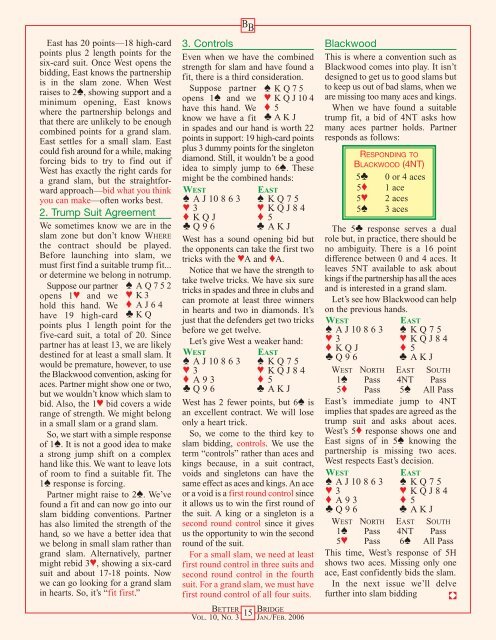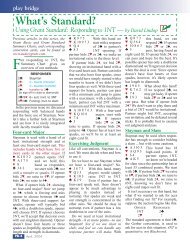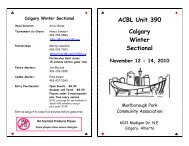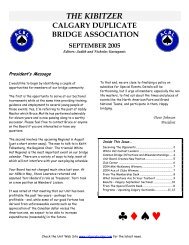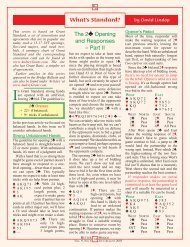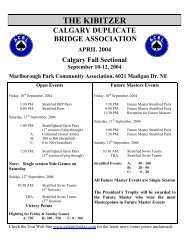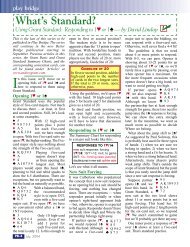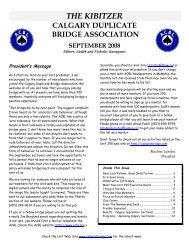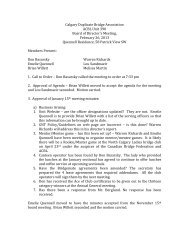What's Standard? Slam Bidding â Part I - Better Bridge
What's Standard? Slam Bidding â Part I - Better Bridge
What's Standard? Slam Bidding â Part I - Better Bridge
Create successful ePaper yourself
Turn your PDF publications into a flip-book with our unique Google optimized e-Paper software.
East has 20 points—18 high-cardpoints plus 2 length points for thesix-card suit. Once West opens thebidding, East knows the partnershipis in the slam zone. When Westraises to 2♠, showing support and aminimum opening, East knowswhere the partnership belongs andthat there are unlikely to be enoughcombined points for a grand slam.East settles for a small slam. Eastcould fish around for a while, makingforcing bids to try to find out ifWest has exactly the right cards fora grand slam, but the straightforwardapproach—bid what you thinkyou can make—often works best.2. Trump Suit AgreementWe sometimes know we are in theslam zone but don’t know WHEREthe contract should be played.Before launching into slam, wemust first find a suitable trump fit...or determine we belong in notrump.Suppose our partneropens 1♥ and wehold this hand. Wehave 19 high-card♠ A Q 7 5 2♥ K3♦ A J 6 4♣ KQpoints plus 1 length point for thefive-card suit, a total of 20. Sincepartner has at least 13, we are likelydestined for at least a small slam. Itwould be premature, however, to usethe Blackwood convention, asking foraces. <strong>Part</strong>ner might show one or two,but we wouldn’t know which slam tobid. Also, the 1♥ bid covers a widerange of strength. We might belongin a small slam or a grand slam.So, we start with a simple responseof 1♠. It is not a good idea to makea strong jump shift on a complexhand like this. We want to leave lotsof room to find a suitable fit. The1♠ response is forcing.<strong>Part</strong>ner might raise to 2♠. We’vefound a fit and can now go into ourslam bidding conventions. <strong>Part</strong>nerhas also limited the strength of thehand, so we have a better idea thatwe belong in small slam rather thangrand slam. Alternatively, partnermight rebid 3♥, showing a six-cardsuit and about 17-18 points. Nowwe can go looking for a grand slamin hearts. So, it’s “fit first.”BETTERVOL. 10, NO. 3B B3. ControlsEven when we have the combinedstrength for slam and have found afit, there is a third consideration.Suppose partneropens 1♠ and wehave this hand. Weknow we have a fit♣ AK Jin spades and our hand is worth 22points in support: 19 high-card pointsplus 3 dummy points for the singletondiamond. Still, it wouldn’t be a goodidea to simply jump to 6♠. Thesemight be the combined hands:WESTWest has 2 fewer points, but 6♠ isan excellent contract. We will loseonly a heart trick.So, we come to the third key toslam bidding, controls. We use theterm “controls” rather than aces andkings because, in a suit contract,voids and singletons can have thesame effect as aces and kings. An aceor a void is a first round control sinceit allows us to win the first round ofthe suit. A king or a singleton is asecond round control since it givesus the opportunity to win the secondround of the suit.For a small slam, we need at leastfirst round control in three suits andsecond round control in the fourthsuit. For a grand slam, we must havefirst round control of all four suits.15♠ K Q 7 5♥ K Q J 10 4♦ 5EAST♠ A J 10 8 6 3 ♠ K Q 7 5♥ 3 ♥ KQJ 84♦ KQ J ♦ 5♣ Q 9 6 ♣ AKJWest has a sound opening bid butthe opponents can take the first twotricks with the ♥A and ♦A.Notice that we have the strength totake twelve tricks. We have six suretricks in spades and three in clubs andcan promote at least three winnersin hearts and two in diamonds. It’sjust that the defenders get two tricksbefore we get twelve.Let’s give West a weaker hand:WESTEAST♠ A J 10 8 6 3 ♠ K Q 7 5♥ 3 ♥ KQJ 84♦ A 9 3 ♦ 5♣ Q 9 6 ♣ AKJBRIDGEJAN./FEB. 2006BlackwoodThis is where a convention such asBlackwood comes into play. It isn’tdesigned to get us to good slams butto keep us out of bad slams, when weare missing too many aces and kings.When we have found a suitabletrump fit, a bid of 4NT asks howmany aces partner holds. <strong>Part</strong>nerresponds as follows:RESPONDING TOBLACKWOOD (4NT)5♣5♦5♥5♠0 or 4 aces1 ace2 aces3 acesThe 5♣ response serves a dualrole but, in practice, there should beno ambiguity. There is a 16 pointdifference between 0 and 4 aces. Itleaves 5NT available to ask aboutkings if the partnership has all the acesand is interested in a grand slam.Let’s see how Blackwood can helpon the previous hands.WESTEAST♠ A J 10 8 6 3 ♠ K Q 7 5♥ 3 ♥ KQJ 84♦ KQ J ♦ 5♣ Q 9 6 ♣ AKJWEST NORTH EAST SOUTH1♠ Pass 4NT Pass5♦ Pass 5♠ All PassEast’s immediate jump to 4NTimplies that spades are agreed as thetrump suit and asks about aces.West’s 5♦ response shows one andEast signs of in 5♠ knowing thepartnership is missing two aces.West respects East’s decision.WESTEAST♠ A J 10 8 6 3 ♠ K Q 7 5♥ 3 ♥ KQJ 84♦ A 9 3 ♦ 5♣ Q 9 6 ♣ AKJWEST NORTH EAST SOUTH1♠ Pass 4NT Pass5♥ Pass 6♠ All PassThis time, West’s response of 5Hshows two aces. Missing only oneace, East confidently bids the slam.In the next issue we’ll delvefurther into slam bidding


